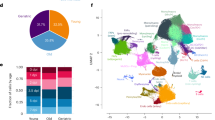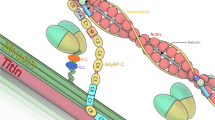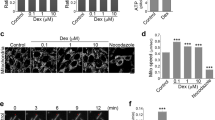Abstract
Acute muscle injury and physiological stress from chronic muscle diseases and aging lead to impairment of skeletal muscle function. This raises the question of whether p53, a cellular stress sensor, regulates muscle tissue repair under stress conditions. By investigating muscle differentiation in the presence of genotoxic stress, we discovered that p53 binds directly to the myogenin promoter and represses transcription of myogenin, a member of the MyoD family of transcription factors that plays a critical role in driving terminal muscle differentiation. This reduction of myogenin protein is observed in G1-arrested cells and leads to decreased expression of late but not early differentiation markers. In response to acute genotoxic stress, p53-mediated repression of myogenin reduces post-mitotic nuclear abnormalities in terminally differentiated cells. This study reveals a mechanistic link previously unknown between p53 and muscle differentiation, and suggests new avenues for managing p53-mediated stress responses in chronic muscle diseases or during muscle aging.
Similar content being viewed by others
Log in or create a free account to read this content
Gain free access to this article, as well as selected content from this journal and more on nature.com
or
Abbreviations
- MRF:
-
myogenic regulatory factor
- ER:
-
estrogen receptor
- BFP:
-
blue fluorescent protein
- 4OHT:
-
4-hydroxytamoxifen
- MEF:
-
mouse embryonic fibroblast
- IR:
-
ionizing radiation
- PI:
-
propidium iodide
- BrdU:
-
bromodeoxyuridine
- ChIP-seq:
-
chromatin immunoprecipitation followed by high-throughput DNA sequencing
- RE:
-
response element
- TAD:
-
transcriptional activation domain
- DHB:
-
human DNA helicase B
References
Vousden KH, Prives C . Blinded by the light: the growing complexity of p53. Cell 2009; 137: 413–431.
Halazonetis TD, Gorgoulis VG, Bartek J . An oncogene-induced DNA damage model for cancer development. Science 2008; 319: 1352–1355.
Brosh R, Rotter V . When mutants gain new powers: news from the mutant p53 field. Nat Rev Cancer 2009; 9: 701–713.
Molchadsky A, Rivlin N, Brosh R, Rotter V, Sarig R . p53 is balancing development, differentiation and de-differentiation to assure cancer prevention. Carcinogenesis 2010; 31: 1501–1508.
Stiewe T . The p53 family in differentiation and tumorigenesis. Nat Rev Cancer 2007; 7: 165–168.
Lin T, Chao C, Saito S, Mazur SJ, Murphy ME, Appella E et al. p53 induces differentiation of mouse embryonic stem cells by suppressing Nanog expression. Nat Cell Biol 2005; 7: 165–171.
Wang B, Xiao Z, Ko HL, Ren EC . The p53 response element and transcriptional repression. Cell Cycle 2010; 9: 870–879.
Berkes CA, Tapscott SJ . MyoD and the transcriptional control of myogenesis. Sem Cell Dev Biol 2005; 16: 585–595.
Bentzinger CF, Wang YX, Rudnicki MA . Building muscle: molecular regulation of myogenesis. Cold Spring Harb Perspect Biol 2012; 4: pii:a008342.
Hasty P, Bradley A, Morris JH, Edmondson DG, Venuti JM, Olson EN et al. Muscle deficiency and neonatal death in mice with a targeted mutation in the myogenin gene. Nature 1993; 364: 501–506.
Zhang P, Wong C, Liu D, Finegold M, Harper JW, Elledge SJ . p21(CIP1) and p57(KIP2) control muscle differentiation at the myogenin step. Genes Dev 1999; 13: 213–224.
Nabeshima Y, Hanaoka K, Hayasaka M, Esumi E, Li S, Nonaka I et al. Myogenin gene disruption results in perinatal lethality because of severe muscle defect. Nature 1993; 364: 532–535.
Rawls A, Valdez MR, Zhang W, Richardson J, Klein WH, Olson EN . Myogenin’s functions do not overlap with those of MyoD or Myf-5 during mouse embryogenesis. Dev Biol 1995; 172: 37–50.
Sartorelli V, Caretti G . Mechanisms underlying the transcriptional regulation of skeletal myogenesis. Curr Opin Genet Dev 2005; 15: 528–535.
Cam H, Griesmann H, Beitzinger M, Hofmann L, Beinoraviciute-Kellner R, Sauer M, Hüttinger-Kirchhof N et al. p53 family members in myogenic differentiation and rhabdomyosarcoma development. Cancer Cell 2006; 10: 281–293.
Halevy O, Novitch BG, Spicer DB, Skapek SX, Rhee J, Hannon GJ et al. Correlation of terminal cell cycle arrest of skeletal muscle with induction of p21 by MyoD. Science 1995; 267: 1018–1021.
Porrello A, Cerone MA, Coen S, Gurtner A, Fontemaggi G, Cimino L et al. p53 regulates myogenesis by triggering the differentiation activity of pRb. J Cell Biol 2000; 151: 1295–1304.
Soddu S, Blandino G, Scardigli R, Coen S, Marchetti A, Rizzo MG et al. Interference with p53 protein inhibits hematopoietic and muscle differentiation. J Cell Biol 1996; 134: 1–12.
Tamir Y, Bengal E . p53 protein is activated during muscle differentiation and participates with MyoD in the transcription of muscle creatine kinase gene. Oncogene 1998; 17: 347–356.
Weintraub H, Hauschka S, Tapscott SJ . The MCK enhancer contains a p53 responsive element. Proc Natl Acad Sci USA 1991; 88: 4570–4571.
Didier N, Hourdé C, Amthor H, Marazzi G, Sassoon D . Loss of a single allele for Ku80 leads to progenitor dysfunction and accelerated aging in skeletal muscle. EMBO Mol Med 2012; 4: 910–923.
Schwarzkopf M, Coletti D, Sassoon D, Marazzi G . Muscle cachexia is regulated by a p53-PW1/Peg3-dependent pathway. Genes Dev 2006; 20: 3440–3452.
Schwarzkopf M, Coletti D, Marazzi G, Sassoon D . Chronic p53 activity leads to skeletal muscle atrophy and muscle stem cell perturbation. Basic Appl Myol 2008; 18: 131–138.
Rodier F, Campisi J, Bhaumik D . Two faces of p53: aging and tumor suppression. Nucleic Acids Res 2007; 35: 7475–7484.
Edwards MG, Anderson RM, Yuan M, Kendziorski CM, Weindruch R, Prolla TA . Gene expression profiling of aging reveals activation of a p53-mediated transcriptional program. BMC Genomics 2007; 8: 80.
Puri PL, Bhakta K, Wood LD, Costanzo A, Zhu J, Wang JY . A myogenic differentiation checkpoint activated by genotoxic stress. Nat Genet 2002; 32: 585–593.
Yang Z, MacQuarrie KL, Analau E, Tyler AE, Dilworth FJ, Cao Y et al. MyoD and E-protein heterodimers switch rhabdomyosarcoma cells from an arrested myoblast phase to a differentiated state. Genes Dev 2009; 23: 694–707.
Tapscott SJ, Thayer MJ, Weintraub H . Deficiency in rhabdomyosarcomas of a factor required for MyoD activity and myogenesis. Science 1993; 259: 1450–1453.
Merlino G, Helman LJ . Rhabdomyosarcoma—working out the pathways. Oncogene 1999; 18: 5340–5348.
Felix CA, Kappel CC, Mitsudomi T, Nau MM, Tsokos M, Crouch GD et al. Frequency and diversity of p53 mutations in childhood rhabdomyosarcoma. Cancer Res 1992; 52: 2243–2247.
Ferreira JP, Overton KW, Wang CL . Tuning gene expression with synthetic upstream open reading frames. Proc Natl Acad Sci USA 2013; 110: 11284–11289.
Vermes I, Haanen C, Steffens-Nakken H, Reutelingsperger C . A novel assay for apoptosis. Flow cytometric detection of phosphatidylserine expression on early apoptotic cells using fluorescein labelled Annexin V. J Immunol Methods 1995; 184: 39–51.
Rubin BP, Nishijo K, Chen HI, Yi X, Schuetze DP, Pal R et al. Evidence for an unanticipated relationship between undifferentiated pleomorphic sarcoma and embryonal rhabdomyosarcoma. Cancer Cell 2011; 19: 177–191.
Buckingham M, Relaix F . The role of Pax genes in the development of tissues and organs: Pax3 and Pax7 regulate muscle progenitor cell functions. Annu Rev Cell Dev Biol 2007; 23: 645–673.
Walter D, Satheesha S, Albrecht P, Bornhauser BC, D'Alessandro V, Oesch SM et al. CD133 positive embryonal rhabdomyosarcoma stem-like cell population is enriched in rhabdospheres. PLoS One 2011; 6: e19506.
Brady CA, Jiang D, Mello SS, Johnson TM, Jarvis LA, Kozak MM et al. Distinct p53 transcriptional programs dictate acute DNA-damage responses and tumor suppression. Cell 2011; 145: 571–583.
Kitzmann M, Fernandez A . Crosstalk between cell cycle regulators and the myogenic factor MyoD in skeletal myoblasts. Cell Mol Life Sci 2001; 58: 571–579.
Singh K, Dilworth FJ . Differential modulation of cell cycle progression distinguishes members of the myogenic regulatory factor family of transcription factors. FEBS J 2013; 280: 3991–4003.
Hostein I, Andraud-Fregeville M, Guillou L, Terrier-Lacombe MJ, Deminière C, Ranchère D et al. Rhabdomyosarcoma: value of myogenin expression analysis and molecular testing in diagnosing the alveolar subtype: an analysis of 109 paraffin-embedded specimens. Cancer 2004; 101: 2817–2824.
Andrés V, Walsh K . Myogenin expression, cell cycle withdrawal, and phenotypic differentiation are temporally separable events that precede cell fusion upon myogenesis. J Cell Biol 1996; 132: 657–666.
Kenzelmann Broz D, Spano Mello S, Bieging KT, Jiang D, Dusek RL, Brady CA et al. Global genomic profiling reveals an extensive p53-regulated autophagy program contributing to key p53 responses. Genes Dev 2013; 27: 1016–1031.
Li M, He Y, Dubois W, Wu X, Shi J, Huang J . Distinct regulatory mechanisms and functions for p53-activated and p53-repressed DNA damage response genes in embryonic stem cells. Mol Cell 2012; 46: 30–42.
Riley T, Sontag E, Chen P, Levine A . Transcriptional control of human p53-regulated genes. Nat Rev Mol Cell Biol 2008; 9: 402–412.
Latella L, Lukas J, Simone C, Puri PL, Bartek J . Differentiation-induced radioresistance in muscle cells. Mol Cell Biol 2004; 24: 6350–6361.
Zhang L, Kim M, Choi YH, Goemans B, Yeung C, Hu Z et al. Diminished G1 checkpoint after gamma-irradiation and altered cell cycle regulation by insulin-like growth factor II overexpression. J Biol Chem 1999; 274: 13118–13126.
Kouwenhoven EN, van Heeringen SJ, Tena JJ, Oti M, Dutilh BE, Alonso ME et al. Genome-wide profiling of p63 DNA-binding sites identifies an element that regulates gene expression during limb development in the 7q21 SHFM1 locus. PLoS Genet 2010; 6: e1001065.
Asp P, Blum R, Vethantham V, Parisi F, Micsinai M, Cheng J et al. Genome-wide remodeling of the epigenetic landscape during myogenic differentiation. Proc Natl Acad Sci USA 2011; 108: E149–E158.
Bulger M, Groudine M . Functional and mechanistic diversity of distal transcription enhancers. Cell 2011; 144: 327–339.
Phatnani HP, Greenleaf AL . Phosphorylation and functions of the RNA polymerase II CTD. Genes Dev 2006; 20: 2922–2936.
Kurabayashi M, Jeyaseelan R, Kedes L . Antineoplastic agent doxorubicin inhibits myogenic differentiation of C2 myoblasts. J Biol Chem 1993; 268: 5524–5529.
Innocenzi A, Latella L, Messina G, Simonatto M, Marullo F, Berghella L et al. An evolutionarily acquired genotoxic response discriminates MyoD from Myf5, and differentially regulates hypaxial and epaxial myogenesis. EMBO Rep 2011; 12: 164–171.
Weintraub H, Tapscott SJ, Davis RL, Thayer MJ, Adam MA, Lassar AB et al. Activation of muscle-specific genes in pigment, nerve, fat, liver, and fibroblast cell lines by forced expression of MyoD. Proc Natl Acad Sci USA 1989; 86: 5434–5438.
Spencer SL, Cappell SD, Tsai FC, Overton KW, Wang CL, Meyer T . The proliferation-quiescence decision is controlled by a bifurcation in CDK2 activity at mitotic exit. Cell 2013; 155: 369–383.
Kurabayashi M, Jeyaseelan R, Kedes L . Doxorubicin represses the function of the myogenic helix-loop-helix transcription factor MyoD. Involvement of Id gene induction. J Biol Chem 1994; 269: 6031–6039.
Nam HJ, van Deursen JM . Cyclin B2 and p53 control proper timing of centrosome separation. Nat Cell Biol 2014; 16: 538–549.
Parker SB, Eichele G, Zhang P, Rawls A, Sands AT, Bradley A et al. p53-independent expression of p21Cip1 in muscle and other terminally differentiating cells. Science 1995; 267: 1024–1027.
Ori A, Zauberman A, Doitsh G, Paran N, Oren M, Shaul Y . p53 binds and represses the HBV enhancer: an adjacent enhancer element can reverse the transcription effect of p53. EMBO J 1998; 17: 544–553.
Marión RM, Strati K, Li H, Murga M, Blanco R, Ortega S et al. A p53-mediated DNA damage response limits reprogramming to ensure iPS cell genomic integrity. Nature 2009; 460: 1149–1153.
Tschaharganeh DF, Xue W, Calvisi DF, Evert M, Michurina TV, Dow LE et al. p53-dependent nestin regulation links tumor suppression to cellular plasticity in liver cancer. Cell 2014; 158: 579–592.
Wallace LM, Garwick SE, Mei W, Belayew A, Coppee F, Ladner KJ et al. DUX4, a candidate gene for facioscapulohumeral muscular dystrophy, causes p53-dependent myopathy in vivo. Ann Neurol 2011; 69: 540–752.
Ehrnhoefer DE, Skotte NH, Ladha S, Nguyen YT, Qiu X, Deng Y et al. p53 increases caspase-6 expression and activation in muscle tissue expressing mutant huntingtin. Hum Mol Genet 2014; 23: 717–729.
Powers SK, Kavazis AN, McClung JM . Oxidative stress and disuse muscle atrophy. J Appl Physiol (1985) 2007; 102: 2389–2397.
Ebert SM, Dyle MC, Kunkel SD, Bullard SA, Bongers KS, Fox DK et al. Stress-induced skeletal muscle Gadd45a expression reprograms myonuclei and causes muscle atrophy. J Biol Chem 2012; 287: 27290–27301.
Moresi V, Williams AH, Meadows E, Flynn JM, Potthoff MJ, McAnally J et al. Myogenin and class II HDACs control neurogenic muscle atrophy by inducing E3 ubiquitin ligases. Cell 2010; 143: 35–45.
Liu L, Rando TA . Manifestations and mechanisms of stem cell aging. J Cell Biol 2011; 193: 257–266.
Jung Y, Brack AS . Cellular mechanisms of somatic stem cell aging. Curr Top Dev Biol 2014; 107: 405–438.
Demontis F, Piccirillo R, Goldberg AL, Perrimon N 2013 Mechanisms of skeletal muscle aging: insights from Drosophila and mammalian models. Dis Model Mech 2013; 6: 1339–1352.
Acknowledgements
We thank members of the Wang laboratory for technical support and stimulating discussions. We are grateful to Drs Ingrid Lawhorn, Phillip Patten, Stefano Biressi, and Maddalena Adorno for valuable discussions and comments on the manuscript; Teddy Yewdell from the Dr Aaron Straight laboratory for helpful discussions; Emma Chory from the Dr Gerald Crabtree laboratory, and Rose Tran and Brook Hunt from the Dr Paul Khavari laboratory for generously providing histone antibodies for preliminary ChIP validations. We thank Dr Foteini Mourkioti for providing antibodies for initial testing of muscle differentiation markers. We also thank the Stanford FACS facility for technical support. This study was supported by NIH-5R21AG040360-02 to CLW and Swiss National Science Foundation Fellowships to DKB.
Author information
Authors and Affiliations
Corresponding authors
Ethics declarations
Competing interests
The authors declare no conflict of interest.
Additional information
Edited by B Zhivotovsky
Supplementary Information accompanies this paper on Cell Death and Differentiation website
Rights and permissions
About this article
Cite this article
Yang, Z., Kenzelmann Broz, D., Noderer, W. et al. p53 suppresses muscle differentiation at the myogenin step in response to genotoxic stress. Cell Death Differ 22, 560–573 (2015). https://doi.org/10.1038/cdd.2014.189
Received:
Revised:
Accepted:
Published:
Issue date:
DOI: https://doi.org/10.1038/cdd.2014.189
This article is cited by
-
Inverse and reciprocal regulation of p53/p21 and Bmi-1 modulates vasculogenic differentiation of dental pulp stem cells
Cell Death & Disease (2021)
-
The transcription factor NF-Y participates to stem cell fate decision and regeneration in adult skeletal muscle
Nature Communications (2021)
-
Muscle differentiation induced by p53 signaling pathway-related genes in myostatin-knockout quail myoblasts
Molecular Biology Reports (2020)
-
Photobiomodulation effects on mRNA levels from genomic and chromosome stabilization genes in injured muscle
Lasers in Medical Science (2018)
-
Activin A more prominently regulates muscle mass in primates than does GDF8
Nature Communications (2017)



